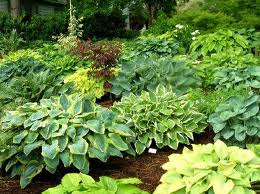Now\’s the Time to Be Preparing Your Perennial Beds
Now\’s the Time to be Preparing Your Perennial Beds
By Deborah Clark
NABBW’s Gardening Expert
 A Chinese proverb says, “To be happy for a year, get married. To be happy for a lifetime, grow a garden.” Is that a gloomy thought about marriage? Perhaps, though we know the Chinese still do it. But who\’d have thought gardening could be so joyful? Probably any gardener you ask…
A Chinese proverb says, “To be happy for a year, get married. To be happy for a lifetime, grow a garden.” Is that a gloomy thought about marriage? Perhaps, though we know the Chinese still do it. But who\’d have thought gardening could be so joyful? Probably any gardener you ask…
The pleasure of growing perennial flowers is that they keep coming back, bigger and more beautiful than before. The work needed to maintain a perennial garden is about the same as for a lawn, at least in the beginning. Once it’s established, though, it won’t require as much attention.
Of course, you must be patient as the results you\’re after may take some time – about three or four years to mature fullness – but as long as your yard isn\’t on top of an old parking lot, you should have no major problems. A perennial garden by definition will be in place for years, so you need to provide a nutritious site for your plants, to get them going and keep them growing.
 One hint about gardening is that you are tending to the plant’s roots. Roots are soft, fragile cells that must force their way through clods of earth and stones and do best in loose, uncompacted soil. Worms help, too, by making tunnels that roots can grow through. As roots spread out, you should avoid disturbing them. Some are close to the surface, so don\’t rake too close to your plants.
One hint about gardening is that you are tending to the plant’s roots. Roots are soft, fragile cells that must force their way through clods of earth and stones and do best in loose, uncompacted soil. Worms help, too, by making tunnels that roots can grow through. As roots spread out, you should avoid disturbing them. Some are close to the surface, so don\’t rake too close to your plants.
Just as you prefer eating a variety of food to swallowing vitamin pills, so does soil prefer organic matter to chemical fertilizers. Dig manure, compost, or peat moss into your soil before you plant your perennials. Peat moss isn\’t a good growing medium by itself, but it helps build poor soil by adding organic matter necessary for friendly microbes, and by increasing its capacity to retain water. Because it\’s porous, peat moss allows air to penetrate soil: roots need oxygen, so soil needs good air circulation.
Avoid digging in soil that\’s soaking wet, especially in spring when it\’s thawing, because this breaks down its composition and compacts it like cement, making it impossible to work with for the rest of the season.
Selecting Your Plantings
As you select plants for your garden, take careful note of the sun and shade conditions in your yard. Some plants like sun, others like shade; some can stand the heat, others like it cool.
- Shadows move during the day, and even during the season, creating part-sun, part-shade sites. So look carefully and figure out what kinds of sites you really do have.
- While the climate where you live has general characteristics, it also has mini-variations known as microclimates. For example, a hill sloping south and in full sun is as warm as a latitude farther south, and one in full shade facing north is as cool as a more northern one.
- So you may have several microclimates in your yard, and that means you can plant more varieties than you may think.
You should research perennials in books, online, by visiting a garden center with informed employees, or by chatting with gardening neighbors to find out if the ones you like will thrive in your own yard. Then assess your plot. Besides noticing the amount of sun, you may want to measure it.
Perennials need space to grow. Don’t crowd them together. Plant labels often list how far to space new plants.
- Most quart pots are planted about 18-24 inches apart while some of the bigger ones like peonies and some of the larger hostas, come in gallon sized pots and are planted 3’ apart: This means that your bed will look a bit bare for a few years, so you can fill in with annuals for the first couple of years.
- After planting perennials, surround them with 3-4 inches of shredded bark mulch that will break down during the season. A layer of mulch performs several jobs — it keeps moisture in the soil, it moderates the soil temperature, and it helps assure that plants don\’t get heaved out of the ground during winter freezes and thaws.
- You can sprinkle around perennials with compost or composted manure.
Be careful not to starve older plants that will eventually need to be lifted and divided; or drown them with too much water; or burn them by applying the wrong kinds of chemicals or fresh manure; and convince your dog to do his business elsewhere, and your perennials will grow and multiply, giving you flowers all around your yard, and fresh bouquets all season.
Deborah Clark says she might never have taken up gardening if she hadn’t had neighbors who shared their love of gardening with her – but moved away.
It all started in 1973, she says, when a departing neighbor invited her to take care of an already-planted community vegetable garden plot: all she had to do was weed and harvest. She was hooked.


Leave a Reply
You must be logged in to post a comment.